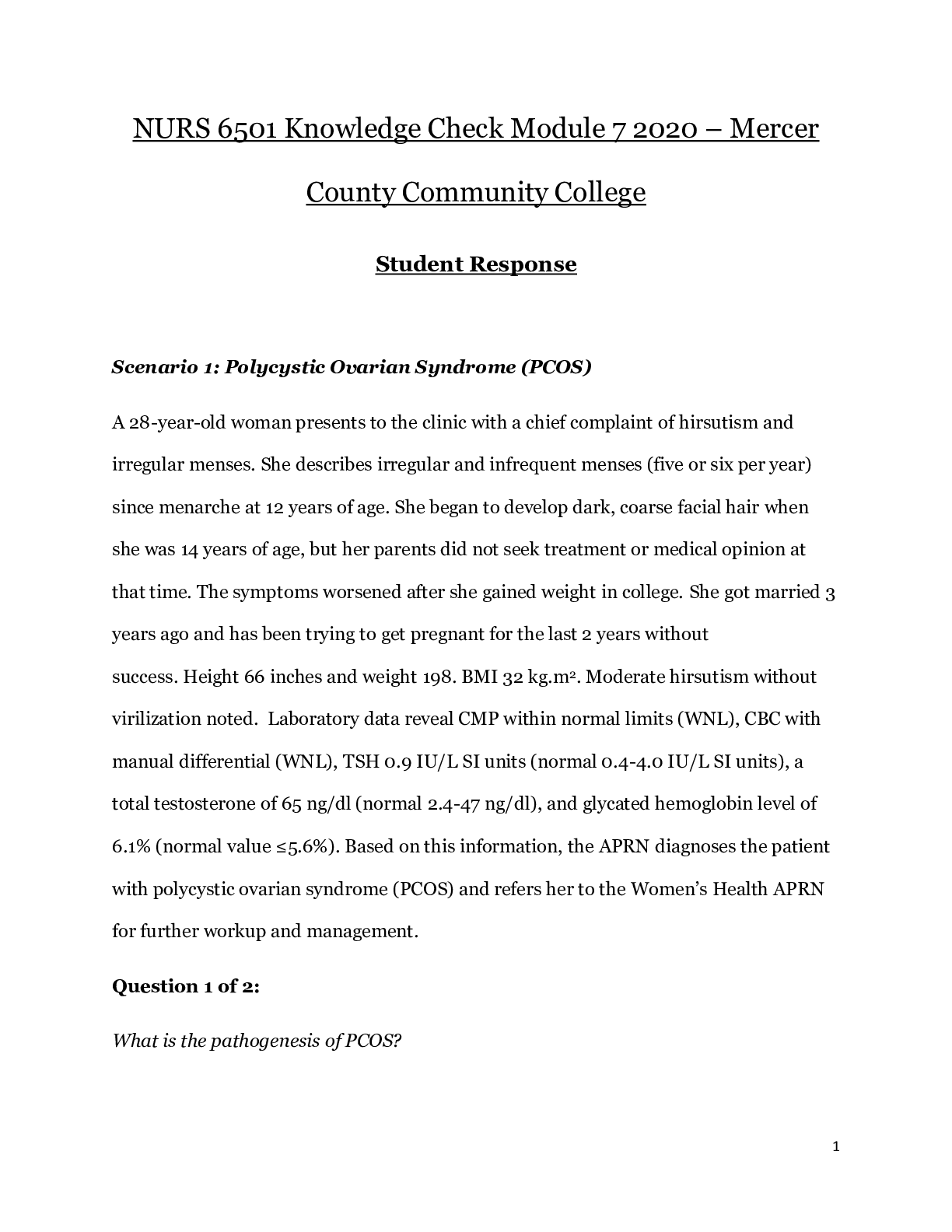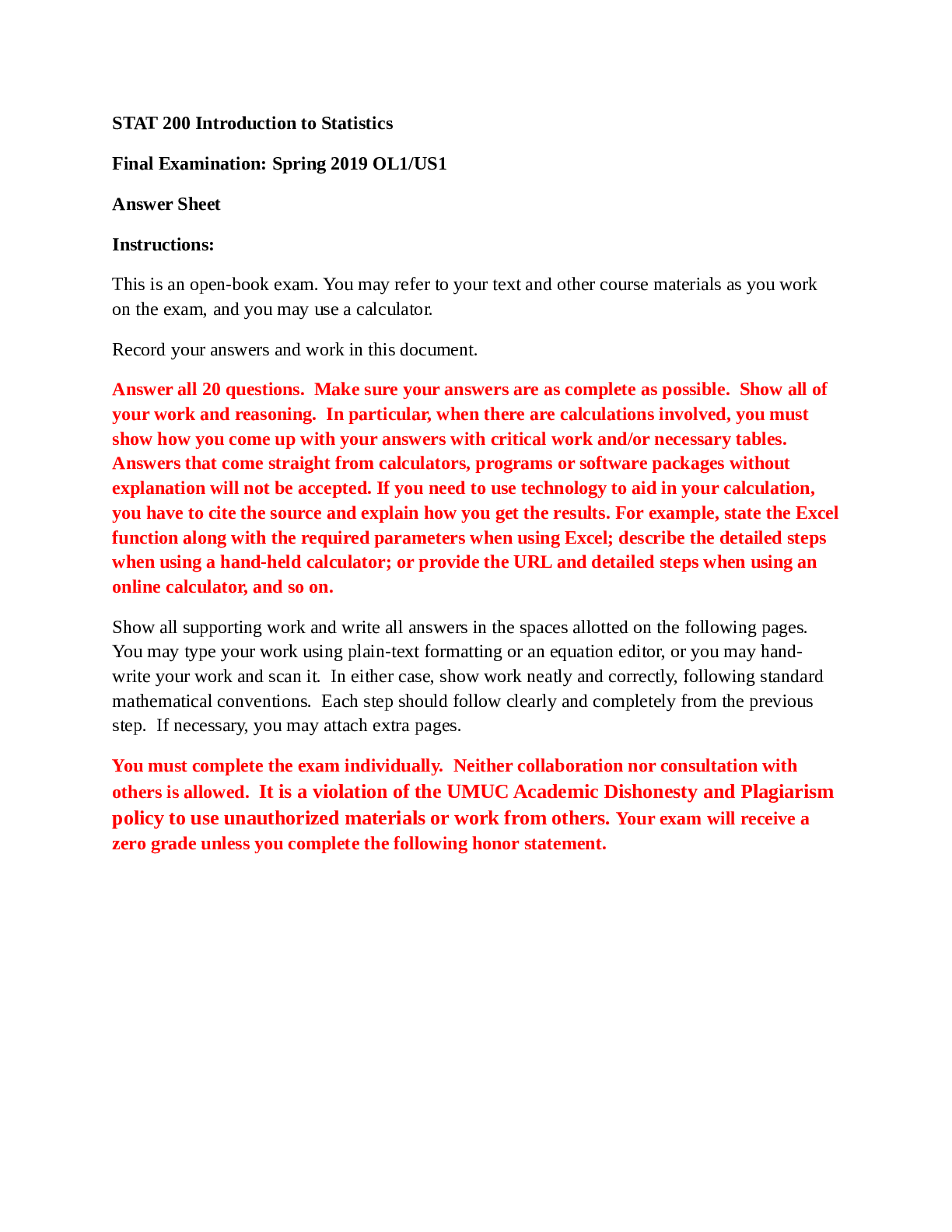*NURSING > EXAM > NURS 6501 Knowledge Check Module 8 2020 – Mercer County Community College | NURS6501 Knowledge Che (All)
NURS 6501 Knowledge Check Module 8 2020 – Mercer County Community College | NURS6501 Knowledge Check Module 8 2020
Document Content and Description Below
NURS 6501 Knowledge Check Module 8 2020 – Mercer County Community College Student Response This Knowledge Check reviews the topics in Module 8 and is formative in nature. It is worth 20 points... where each question is worth 1 point. You are required to submit a sufficient response of at least 2-4 sentences in length for each question. Scenario 1: Acute Lymphoblastic Leukemia (ALL) A ten-year-old boy is brought to clinic by his mother who states that the boy has been listless and not eating. She also notes that he has been easily bruising without trauma as he says he is too tired to go out and play. He says his bones hurt sometimes. Mother states the child has had intermittent fevers that respond to acetaminophen. Maternal history negative for pre, intra, or post-partum problems. Child’s past medical history negative and he easily reached developmental milestones. Physical exam reveals a thin, very pale child who has bruises on his arms and legs in no particular pattern. The APRN orders complete blood count (CBC), and complete metabolic profile (CMP). The CBC revealed Hemoglobin of 6.9/dl, hematocrit of 19%, and platelet count of 80,000/mm3. The CMP demonstrated a blood urea nitrogen (BUN) of 34m g/dl and creatinine of 2.9 mg/dl. The APRN recognizes that the patient appears to have acute leukemia and renal failure and immediately refers the patient to the Emergency Room where a pediatric hematologist has been consulted and is waiting for the boy and his mother. The diagnosis of acute lymphoblastic leukemia (ALL) was made after extensive testing. Question 1 of 2: What is ALL? Acute lymphoblastic leukemia (ALL) is a malignant clonal disease of the bone marrow in which early lymphoid precursors proliferate and replace the normal hematopoietic cells of the marrow. ALL is the most common type of cancer and leukemia in children in the United States. The malignant cells of acute lymphoblastic leukemia (ALL) are lymphoid precursor cells (ie, lymphoblasts) that are arrested in an early stage of development. This arrest is caused by an abnormal expression of genes, often as a result of chromosomal translocations or abnormalities of chromosome number. These aberrant lymphoblasts proliferate, reducing the number of the normal marrow elements that produce other blood cell lines (red blood cells, platelets, and neutrophils). Consequently, anemia, thrombocytopenia, and neutropenia occur, although typically to a lesser degree than is seen in acute myeloid leukemia. Lymphoblasts can also infiltrate outside the marrow, particularly in the liver, spleen, and lymph nodes, resulting in enlargement of the latter organs. Question 2 of 2: How does renal failure occur in some patients with ALL? Renal failure occurs in some patients with ALL as a result of hyperuricemia. Uric levels rise as an end product of purine metabolism from cellular destruction. Because the major excretory pathway is through the kidneys, urates can precipitate in renal tubules or ureters and can lead to oliguria and acute renal failure. Scenario 2: Sickle Cell Disease (SCD) A 12-year-old female with known sickle cell disease (SCD) present to the Emergency Room in sickle cell crisis. The patient is crying with pain and states this is the third acute episode she has had in the last nine months. Both parents are present and appear very anxious and teary eyed. A diagnosis of acute sickle cell crisis was made. Appropriate therapeutic interventions were initiated by the APRN and the patient’s pain level decreased, and she was transferred to the pediatric intensive care unit (PICU) for observation and further management. Question 1 of 2: What is the pathophysiology of acute SCD crisis and why is pain the predominate feature of acute crises? The pathogenesis of sickling includes erythrocyte derangement, chronic hemolysis, microvascular occlusions, and tissue damage. Deoxygenation is probably the most important variable in determining the occurrence of sickling. Other significant variables that affect sickling include interaction of Hbs with other types of hemoglobin in the cell, mean cell hemoglobin concentration (MCHC), intracellular pH, and transit times of erythrocytes through the microcirculation. The intense pain of an acute crisis is due to lack of oxygen to major organs and bones. The lack of oxygen leads to ischemia and organ death. Question 2 of 2: Discuss the genetic basis for SCD. SCD denotes all genotypes containing at least one sickle gene, in which HbS makes up at least half the hemoglobin present. Major sickle genotypes described so far include the following: • HbSS disease or sickle cell anemia (the most common form) - Homozygote for the S globin with usually a severe or moderately severe phenotype and with the shortest survival • HbS/b-0 thalassemia - Double heterozygote for HbS and b-0 thalassemia; clinically indistinguishable from sickle cell anemia (SCA) • HbS/b+ thalassemia - Mild-to-moderate severity with variability in different ethnicities • HbSC disease - Double heterozygote for HbS and HbC characterized by moderate clinical severity • HbS/hereditary persistence of fetal Hb (S/HPHP) - Very mild or asymptomatic phenotype Sickle cell trait or the carrier state is the heterozygous form characterized by the presence of around 40% HbS, absence of anemia, inability to concentrate urine (isosthenuria), and hematuria. Under conditions leading to hypoxia, it may become a pathologic risk factor. Sickle cell disease produces illness, while sickle cell trait usually does not. People who inherit two genes for sickle hemoglobin (one from each parent) have sickle cell disease. With a few exceptions, a child can inherit sickle cell disease only if both parents have one gene for sickle cell hemoglobin. Scenario 3: Hemophilia The parents of a 9-month boy bring the infant to the pediatrician’s office for evaluation of a swollen right knee and excessive bruising. The parents have noticed that the baby began having bruising about a month ago but thought the bruising was due to the child’s attempts to crawl. They became concerned when the baby woke up with a swollen knee. Infant up to date on all immunizations, has not had any medical problems since birth and has met all developmental milestones. Pre-natal, intra-natal, and post-natal history of mother noncontributory. Family history negative for any history of bleeding disorders or other major genetic diseases. Physical exam within normal limits except for obvious bruising on the extremities and right knee. Knee is swollen but no warmth appreciated. Range of motion of knee limited due to the swelling. The pediatrician suspects the child has hemophilia and orders a full bleeding panel workup which confirms the diagnosis of hemophilia A. - - - - - - - - - - - - - - - - - - - - - - - - - - Question: What is the pathophysiology of HUS? HUS has been associated with both bacterial and viral agents, as well as endotoxins, especially from E. Coli 0157:H7 and E. Coli 0104:H4. HUS is usually preceded by a colitis caused by Shiga toxin– producing Escherichia coli (STEC). Subsequent inflammation of the colon facilitates systemic absorption of the shiga toxin and lipopolysaccharide from the GI tract. The toxin binds to polymorphonuclear leukocytes in the gut and is transported to the kidney, causing a cascade of effects, including lysis of glomerular capillary endothelial cells, separation of endothelial cells from the basement membrane, activation and aggregation of platelets and the activation of the coagulation cascade. The glomerular arterioles become swollen and occluded with platelets and fibrin clots. There is decreased glomerular filtration and the damaged glomerular membrane results in hematuria and proteinuria. Narrow vessels injure passing erythrocytes. The damaged erythrocytes are removed by the spleen, causing acute hemolytic anemia. Severe thrombocytopenia ensues. Scenario 13: Pituitary Dwarfism The parents of a 3-year-old boy bring the child to the pediatrician with concerns that their child seems “small for his age”. The parents state that the boy has always been small but did not worry until the child went to day care and they noticed other children of the same age were much bigger. They also note that his teeth were very late in coming in. Normal prenatal, perinatal and postnatal history and no medical history on either side of family regarding issues with growth and development. Physical exam is normal except for short limbs and small teeth. The pediatrician suspects the child has pituitary dwarfism. A complete laboratory and radiographic work up confirmed the diagnosis. Question: What is the pathophysiology of pituitary dwarfism? Growth hormone deficiency (GHD), also known as dwarfism or pituitary dwarfism, is a condition caused by insufficient amounts of growth hormone in the body. Children with GHD have abnormally short stature with normal body proportions. GHD can be present at birth (congenital) or develop later (acquired). The condition occurs if the pituitary gland makes too little growth hormone. It can be also the result of genetic defects, severe brain injury or being born without a pituitary gland. In some cases, there is no clear cause identified. Sometimes, GHD can be associated with lower levels of other hormones, such as vasopressin (which controls water production in the body), gonadotropins (which controls the production of male and female sex hormones), thyrotropins (which control the production of thyroid hormones) or adrenocorticotrophic hormone (which controls the adrenal gland and related hormones). Scenario 14: Osteogenesis Imperfecta (OI) A 4-year-old boy was brought to the Emergency Room by his parents with a suspected femur fracture. The parents state the child was playing on the couch when he rolled off and cried out in pain. There were no other injuries noted. Review of the child’s chart revealed this was the 4th Emergency Room visit in the last 15 months for fractures after low impact injury. The parents were suspected of child abuse and Child and Protective Services were consulted. The APRN assessing the child noted that the child had unusually thin and translucent skin, poor dentition, and blue sclera. The APRN suspects the child may have osteogenesis imperfecta (OI). Laboratory results revealed an elevated serum alkaline phosphatase and the diagnosis OI was made based on the clinical picture and elevated alkaline phosphatase. Question: What is the pathophysiology of OI? The major errors in OI lies in the synthesis of collagen, a triple helix with two matching alpha chains and one beta chain. Collagen is presented in the bone, cartilage, eye tissue, skin and vascular system. The severity of OI phenotype and the related anomalies of the eye, dentition, or vascular system are all dependent on the severity of the genetic anomaly and the part of the triple helix that is affected. [Show More]
Last updated: 2 years ago
Preview 1 out of 21 pages

Buy this document to get the full access instantly
Instant Download Access after purchase
Buy NowInstant download
We Accept:

Reviews( 0 )
$16.50
Can't find what you want? Try our AI powered Search
Document information
Connected school, study & course
About the document
Uploaded On
Nov 12, 2020
Number of pages
21
Written in
Additional information
This document has been written for:
Uploaded
Nov 12, 2020
Downloads
0
Views
90








 – University of the People.png)














